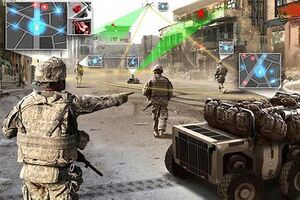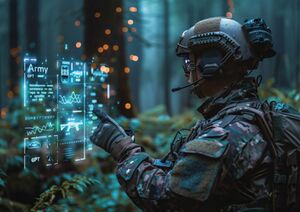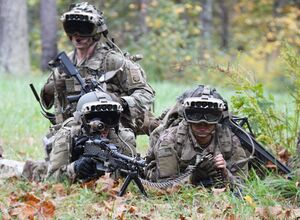HERMES Collaborative Combat Network
| HERMES Collaborative Combat Network | |
|---|---|
 Emblem of the HERMES program | |
| Type | Network-centric warfare system |
| Place of origin | |
| Service history | |
| In service | 2027-present |
| Used by | Burgoignesc Security Forces |
| Production history | |
| Designed | 2003 |
The HERMES Collaborative Combat Network, colloquially called HERMES is the Burgoignesc network-centric warfare system used by all branches of the Burgoignesc Security Forces. HERMES serves as a crucial link between soldiers, vehicles, surveillance posts, and command centers. By providing real-time information and communication capabilities, it enhances situational awareness for front-line soldiers, equips commanders with a common operating picture, and ensures logistics and maintenance personnel are equipped with real time information about the resupply, refueling, and maintenance requirements of their unit's vehicles and equipment. This comprehensive and interconnected network not only significantly enhances the safety and success of the troops in the field, it revolutionizes the efficiency and effectiveness of Burgoignesc military operations, and as a result of both of those outcomes reduces costs overall.
Development


The conceptualization of the HERMES system began with a comprehensive analysis of the existing challenges and limitations faced by the Army of Burgundie as part of the Army of Burgundie Force Restructuring Act of 2003 in the rapidly evolving landscape of modern warfare. Recognizing the need for a comprehensive and interconnected combat network that could enhance situational awareness, streamline logistics operations, and facilitate real-time decision-making processes, military strategists and technology experts collaborated to outline the foundational principles and requirements for the development of the HERMES system. During the initial phase of development (2003-2006), extensive research and development initiatives were undertaken to explore the feasibility of integrating advanced communication technologies, data analytics capabilities, and artificial intelligence algorithms into a unified and resilient combat network. Interdisciplinary teams of military experts, engineers, and software developers worked in tandem to refine the conceptual framework of HERMES, aligning it with the strategic objectives and operational requirements of the Army.
The subsequent phase of HERMES development (2007-2015) was marked by intensive prototyping and testing efforts aimed at validating the efficacy and reliability of the system's key components and functionalities. State-of-the-art simulation facilities and testing grounds were established to facilitate the rigorous evaluation of HERMES in simulated combat environments, enabling military personnel and technology experts to assess its performance under various operational scenarios and stress conditions. Advanced prototype models of wearable communication devices, vehicle sensors, and command center interfaces were developed and subjected to comprehensive testing to ensure seamless interoperability and compatibility within the HERMES network. Sophisticated data analytics algorithms were refined and fine-tuned to process and analyze large volumes of real-time data generated by the system, enabling military commanders and strategists to gain valuable insights and intelligence for informed decision-making on the battlefield. The vehicle sensors, and command center interfaces were deemed a success, but the technology for the wearables made the ergonomically impossible to use in a combat environment at the time.
From 2015-2021 focus was shifted from the vehicle sensors, and command center interfaces to the solicitation for and refinement of the wearables, with particular focus on finding way around reducing or eliminating nausea and reducing the size of the visor, reducing the size and weight of the battery and also reducing the power draw of the visor to increase battery life.
The successful completion of the prototyping and testing phase paved the way for the comprehensive integration and deployment of the HERMES system within the operational testing framework of the Army of Burgundie in early 2023. Strategic partnerships with leading technology firms and defense contractors were established to facilitate the large-scale production and deployment of HERMES-enabled devices, equipment, and infrastructure across field testing units and command centers throughout Burgundie. Comprehensive training programs and educational initiatives were implemented to familiarize Burgoignesc Foreign Legion and the National Gendarmerie of Burgundie personnel with the operational intricacies and functionalities of the HERMES system, emphasizing the importance of data security, effective communication protocols, and strategic decision-making processes within the context of modern warfare. Furthermore, a dedicated team of technical experts and support staff was established to oversee the seamless integration and deployment of HERMES, providing ongoing assistance and guidance to military personnel throughout the transition phase which lasted until 2029. In that year the program was adopted into the 21st Century Burgoignesc Power Projection Stratagem by Crown Princess Amelia and given the remit to expand its reach to all branches of the Burgoignesc Security Forces.
As HERMES became fully integrated into the operational framework of some of the more cutting-edge Army units, efforts were directed towards optimizing its performance and expanding its capabilities to meet the evolving demands and challenges of contemporary military operations based on the field-testing data. Ongoing research and development initiatives were conducted to explore the integration of emerging technologies, such as augmented reality training simulations, unmanned aerial systems, and autonomous vehicles, into the HERMES network, further enhancing its intelligence-gathering and decision-making capabilities. Continuous feedback mechanisms and performance evaluation protocols were implemented to assess the operational efficiency and effectiveness of HERMES-enabled devices and infrastructure, enabling military engineers and technology experts to identify areas for refinement and enhancement within the system. This iterative approach to optimization and expansion fostered a culture of continuous learning and adaptation within the Burgoignesc Security Forces, ensuring that HERMES remained at the forefront of technological innovation and strategic excellence in the rapidly evolving landscape of modern warfare.
The successful development and integration of the HERMES system within the 21st Century Burgoignesc Power Projection Stratagem have yielded significant achievements in increased readiness, reduction of logistics requirements through preventative maintenance, and global network of sensors and information collectors that are ensuring data-driven decision making leads the Burgoignesc Security Forces in the 21st century. By enhancing situational awareness, optimizing logistics operations, and empowering strategic decision-making processes, HERMES has played a pivotal role in strengthening the overall capabilities and readiness of the Burgoignesc military in addressing a wide range of security challenges and global threats.
The legacy of HERMES extends beyond its technological advancements, encompassing a culture of innovation, excellence, and resilience that has permeated throughout the Burgoignesc Security Forces. The strategic integration of advanced technologies and collaborative combat networks has redefined the operational landscape of the Burgoignesc military, enabling it to uphold its commitment to national security and defense with unparalleled efficiency and effectiveness in the face of emerging security challenges and complex geopolitical dynamics.
Operations and Capabilities
HERMES has 5 major areas of connectivity and information sharing:
- Front-Line Soldier Situational Awareness
- Common Operating Picture for Commanders
- Logistics and Maintenance Support
- Augmented Reality Training
- Research and Development
Front-Line Soldier Situational Awareness

HERMES is built to empower the Army of Burgundie's tactical approach which is "Le Strates prepares and expects all of its soldiers, at all levels, to take the initiative and take an adaptive approach to complete orders and meet objectives." The system is designed to empower front-line soldiers with comprehensive situational awareness, enabling them to make informed decisions in dynamic and challenging environments. Integrated wearable technology, such as advanced heads-up displays and body-worn sensors, provides real-time data on the surrounding terrain, potential threats, and the location of friendly forces. This information is transmitted through a secure network, allowing soldiers to visualize the battlefield and identify potential threats, thereby minimizing the element of surprise and enhancing their ability to react swiftly and effectively. Furthermore, the network facilitates seamless communication between individual soldiers, squads, and platoons, ensuring that critical information, such as tactical updates, orders, and intelligence reports, is shared instantly. This not only fosters better coordination and synergy among units but also enhances the overall effectiveness and responsiveness of the troops on the ground. Additionally, the network enmeshes advanced communication tools, including encrypted voice and video communication, enabling soldiers to maintain constant contact with their commanders and fellow soldiers, thereby fostering a sense of unity and shared purpose.
Common Operating Picture for Commanders
HERMES serves as a powerful tool for commanders, providing them with a comprehensive and real-time common operating picture (COP) of the entire battlefield. Through an coordinated system of advanced sensors, drones, and satellite imagery, commanders obtain a detailed and accurate assessment of the tactical landscape, enemy positions, and potential threats. This data is consolidated and displayed on advanced command center screens, allowing commanders to monitor the progress of the operation and make informed decisions based on real-time intelligence. The HERMES network facilitates the consolidation of data from various sources, including reconnaissance and surveillance reports, sensor data, and input from front-line soldiers. This integration enables commanders to assess the evolving situation effectively, identify key strategic opportunities, and deploy indirect fire and resources in a timely and efficient manner. Furthermore, the network's data analytics capabilities enable commanders to conduct predictive analysis, thereby anticipating potential enemy movements and formulating preemptive strategies to gain a tactical advantage.
Logistics and Maintenance Support

A critical aspect of HERMES is its ability to provide logistics and maintenance personnel with real-time information on the resupply, refueling, and maintenance requirements of their unit's vehicles and equipment. Through sensors and diagnostic tools installed in Burgoignesc vehicles, maintenance personnel monitor key performance metrics, such as engine health, fuel consumption, and equipment functionality. This real-time data allows for proactive maintenance, reducing the risk of unexpected vehicle breakdowns and ensuring that vehicles remain operational and mission-ready at all times. Furthermore, the network streamlines the logistics process by providing real-time updates on the availability of essential supplies, ammunition, and spare parts. This information enables logistics personnel to optimize supply chain management, ensuring that critical resources are available when and where they are needed most. Additionally, the network's predictive maintenance capabilities enable maintenance personnel to anticipate potential issues before they escalate, thereby minimizing downtime and ensuring that vehicles and equipment remain in peak condition throughout the duration of the operation.
Augmented Reality Training

The data collected by HERMES serves as a foundational resource for generating augmented reality (AR) training scenarios that accurately replicate the complexities and dynamics of actual combat situations. By analyzing data on enemy tactics, terrain conditions, and operational challenges from previous engagements, Burgoignesc trainers and AI systems develop realistic and contextually relevant training scenarios that challenge soldiers to apply their tactical knowledge and skills in simulated high-pressure environments. This data-driven approach to scenario generation ensures that AR training exercises are aligned with actual combat experiences, enabling soldiers to gain valuable insights and practical experience that enhance their readiness and effectiveness in real-world Burgoignesc military operations. Using AI-driven algorithms, HERMES enables the generation of adaptive and responsive AR training scenarios that dynamically adjust based on soldiers' actions and decisions. By analyzing real-time data and user interactions, AI systems introduce variable challenges and contingencies within the training environment, thereby simulating the unpredictability and fluidity of actual combat situations. This dynamic and responsive approach to scenario generation fosters a challenging and engaging training experience that encourages soldiers to adapt and respond effectively to evolving threats and changing tactical environments, thereby enhancing their overall readiness and resilience in complex operational settings. The use of AR technology in the HERMES network enables the creation of immersive and interactive training environments that closely replicate the sensory experiences and challenges of real-world combat scenarios. By overlaying virtual elements, such as simulated enemy forces, tactical objectives, and dynamic terrain features, onto soldiers' physical surroundings, AR technology creates a highly immersive and engaging training environment that enables soldiers to practice critical skills, tactics, and decision-making processes in a realistic and dynamic setting. Integrating advanced sensory feedback systems, such as haptic feedback vests and auditory cues, enhances the realism and intensity of HERMES' AR training environments, enabling soldiers to experience the physical sensations and psychological pressures associated with combat situations. This multisensory approach to AR training fosters a holistic and immersive learning experience that prepares soldiers to effectively manage stress, make informed decisions under pressure, and collaborate seamlessly with their fellow team members, thereby enhancing their overall effectiveness and resilience in high-stakes operational environments. This nuanced and comprehensive approach to scenario generation enables soldiers to develop a holistic understanding of the operational complexities and ethical considerations associated with contemporary military engagements, thereby fostering a well-rounded and adaptive approach to tactical decision-making and strategic planning in diverse and dynamic operational settings.
HERMES enables real-time performance evaluation and feedback mechanisms that provide soldiers with actionable insights and guidance to improve their tactical skills and decision-making capabilities. By incorporating performance metrics, such as response time, accuracy, and strategic effectiveness, into the AR training environment, trainers assess soldiers' proficiency and competence in handling simulated combat situations and provide timely and personalized feedback that identifies areas for improvement and development. Using AI-driven analytics enables commanders to conduct a comprehensive analysis of soldiers' performance data, facilitating the identification of individual strengths and weaknesses and the development of targeted training programs and skill enhancement initiatives. This data-driven approach to performance evaluation and feedback not only fosters a culture of continuous learning and improvement among soldiers but also enables Burgoignesc trainers to tailor training interventions and resources to address specific skill gaps and tactical deficiencies, thereby enhancing soldiers' overall readiness and effectiveness in real-world combat environments.
HERMES' training capacity promotes a culture of continuous learning and adaptation among Burgoignesc military personnel, fostering a mindset of proactive engagement and resilience in the face of evolving and dynamic operational environments, already a key element of the Burgoignesc Foreign Legion. By providing soldiers with regular access to diverse and challenging training scenarios, AR technology enables them to refine their tactical skills, expand their strategic thinking capabilities, and develop innovative approaches to addressing complex and multifaceted operational challenges. The integration of ongoing performance evaluation and feedback mechanisms encourages soldiers, and by extension the entire Burgoignesc Security Forces, to actively seek opportunities for self-improvement and professional development, fostering a culture of continuous self-assessment and skill enhancement that ensures their readiness and effectiveness in diverse and demanding operational contexts. This proactive and adaptive approach to training and development not only enhances soldiers' individual capabilities but also contributes to the overall agility and operational readiness of Burgoignesc units, enabling them to respond effectively to emerging threats and dynamic security challenges in the modern landscape of warfare.
Research and Development
The data collected from combat engagements is instrumental in driving continuous improvements to the protective gear and personal equipment used by soldiers. By analyzing data on injuries, equipment failures, and the effectiveness of existing protective measures, military engineers and researchers use HERMES to identify areas for enhancement and innovation in protective gear design. This data-driven approach enables the development of advanced body armor, helmets, and personal protective equipment that offer enhanced protection against ballistic threats, shrapnel, and blast impacts, thereby significantly reducing the risk of life-threatening injuries and casualties on the battlefield. The data collected from soldiers' feedback and assessments of their equipment provides valuable insights into the usability and comfort of protective gear. By integrating soldiers' experiences and suggestions into the design and development process, military engineers can create ergonomically optimized and user-friendly protective gear that minimizes discomfort and fatigue during prolonged combat operations. This iterative approach to equipment design ensures that soldiers are equipped with highly functional and reliable gear that enhances their mobility, agility, and overall survivability in challenging and demanding combat environments.
Data collected by HERMES also plays a crucial role in improving the performance and functionality of vehicles. By analyzing data on vehicle malfunctions, operational inefficiencies, and maintenance requirements, engineers identify areas for optimization and enhancement in vehicle design and functionality. This results in the development of specifications for new military vehicles that offer superior mobility, endurance, and operational capabilities in diverse and adverse terrains, or it drives the retrofit of existing vehicles to higher specifications, primarily focused on enhancing survivability. The data collected from vehicle sensors and diagnostic systems provides valuable insights into the performance and health of key vehicle components, such as engines, transmissions, and suspension systems. This allows maintenance personnel to proactively identify potential issues and implement timely maintenance and repair protocols that prevent critical system failures and breakdowns during crucial combat operations. This proactive approach to vehicle maintenance and performance optimization ensures that Burgoignesc military vehicles remain operationally ready and reliable, thereby minimizing the risk of logistical disruptions and ensuring the timely deployment of resources to support soldiers in the field, which is critical in its primarily expeditionary role.
HERMES serves as a catalyst for the integration of advanced technologies that further enhance the survivability of soldiers and the effectiveness of military equipment and vehicles. By leveraging data analytics and artificial intelligence, the Burgoignesc Security Forces develop predictive models and simulations that assess the potential impact of various threats and combat scenarios on soldier survivability and equipment functionality. This predictive approach enables commanders to formulate preemptive strategies and deploy advanced defensive measures that mitigate risks and enhance the overall resilience of their soldiers in the face of evolving and complex threats. The integration of advanced technologies, such as autonomous vehicles, unmanned aerial systems, and advanced sensor networks, enhances the reconnaissance and surveillance capabilities of Burgoignesc military units, providing real-time intelligence on enemy movements and potential threats. By leveraging this comprehensive and real-time data, Burgoignesc commanders make informed decisions that optimize resource allocation, enhance strategic positioning, and ensure the effective execution of tactical operations, thereby significantly improving the survivability of soldiers and the overall success of combat engagements.
To ensure the continuous improvement of soldier survivability and military equipment functionality, HERMES integrates a robust feedback loop that encourages active participation and input from soldiers, commanders, and maintenance personnel. By soliciting feedback on the effectiveness of protective gear, equipment performance, and operational strategies, the Burgoignesc Security Forces identify areas for refinement and innovation that address the evolving needs and challenges faced by soldiers in combat environments. This collaborative approach to feedback and improvement fosters a culture of continuous learning and adaptation, ensuring that Burgoignesc Security Forces remain agile and responsive to emerging threats and dynamic operational requirements. This feedback loop facilitates a seamless exchange of information between frontline soldiers and military engineers, enabling the rapid integration of user-driven insights into the design and development of protective gear and vehicles. This iterative process of refinement and innovation ensures that Burgoignesc military assets are continuously optimized to meet the demands of evolving combat scenarios and emerging security challenges, thereby enhancing the survivability of soldiers and the overall effectiveness of Burgoignesc military operations.